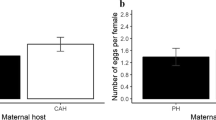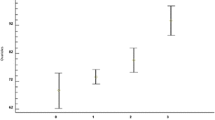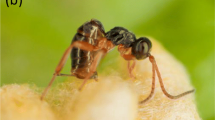Abstract
The fertility of hybrids from two distinct populations of Amblyomma cajennense from different ecological regions of Northern Argentina was analyzed. Two colonies of A. cajennense from El Rey National Park (RNP), Salta Province (24º41′S, 64º36′W), and Copo National Park (CNP), Santiago del Estero Province (25º55′S, 61º43′W) were established infesting rabbits with adults collected from vegetation. Reproductive parameters of the first generation in laboratory of each colony and their crosses were evaluated considering engorged weight of females, engorged period of females, pre-oviposition period of females, minimum egg incubation period, reproductive efficiency index [REI = number of eggs laid/weight of the females in mg], and fertility efficiency index [FEI = number of hatched larvae/weight of the females in mg]. Infestations were made as follows: Group 1) RNP males and females; Group 2) CNP males and females; Group 3) males from CNP and females from RNP; Group 4) males from RNP and females from CNP. The engorgement weight of the females from CNP that mated with males from RNP was significantly lighter than those of the engorged females obtained in the other 3 crosses, and the engorged period of the females from CNP that mated with males from RNP was significantly longer that the engorged period of the females belonging to the remaining groups. The females from group 3 and 4 had a FEI extremely low in comparison with the FEI obtained from the engorged females originated from the groups 1 and 2. Biological implication of these findings is discussed.
Similar content being viewed by others
References
Aguirre DH, Gaido AB, Cafrune MM, Castelli ME, Mangold AJ, Guglielmone AA (2005) Eprinomectin pour-on for control of Boophilus microplus (Canestrini) ticks (Acari: Ixodidae) on cattle. Vet Parasitol 127:157–163
Beati L, Barros-Battesti D, Labruna MB, Guglielmone AA, Guzman Cornejo MC, Cáceres AG, Faccini JLH, Léon R, Blackford EJ (2007) Phylogeography of Amblyomma cajennense (Fabricius, 1787) (Acari: Ixodidae), a widespread American tick species, based on the analysis of mitochondrial gene sequences. 56th Annual meeting, entomological society of America, San Diego, CA, Abstract 834
Beldoménico PM, Baldi JC, Antoniazzi LR, Orduna GM, Mastropaolo M, Macedo AC, Ruiz MF, Orcellet VM, Peralta JL, Venzal JM, Mangold AJ, Guglielmone AA (2003) Ixodid ticks (Acari: Ixodidae) present at parque nacional El Rey, Argentina. Neotrop Entomol 32:273–277
Cabrera AL (1994) Enciclopedia Argentina de Agricultura y Jardinería. Fascículo 1. Regiones fitogeográficas argentinas. Tomo II. Editorial ACME, Buenos Aires
de Queiroz K (2005) Ernst Mayr and the modern concept of species. Proc Natl Acad Sci USA 102(Suppl 1):6600–6607
Drummond RO, Whetstone TM (1970) Oviposition of the gulf coast tick. J Econ Entomol 63:1547–1551
Edmands S (2002) Does parental divergence predict reproductive compatibility? Trends Ecol Evol 17:520–527
Estrada-Peña A, Guglielmone AA, Mangold AJ (2004) The distribution and ecological “preferences” of the tick Amblyomma cajennense (Acari: Ixodidae), an ectoparasite of humans and other mammals in the Americas. Ann Trop Med Parasitol 98:283–292
Gourbiére S, Mallet J (2009) Are species real? The shape of the species boundary with exponential failure, reinforcement, and the “missing snowball”. Evolution 64:1–24
Guglielmone AA, Nava S (2006) Las garrapatas argentinas del género Amblyomma (Acari: Ixodidae): distribución y hospedadores. Rev Investig Agropecu 35:135–155
Guglielmone AA, Mangold AJ, Aguirre DH, Gaido AB, De Olsen AA (1989) The effect of infection by Babesia sp. on some biological parameters of engorged females of Boophilus microplus. Folia Parasitol 36:1–6
Guglielmone AA, Mangold AJ, Oyola BC (1992) Ciclo de vida del Amblyomma cajennense (Fabricius, 1787) (Acari: Ixodidae) en condiciones de laboratorio. Rev Med Vet (B Aires) 73:184–187
Guglielmone AA, Estrada Peña A, Keirans JE, Robbins RG (2003) Ticks (Acari: Ixodida) of the Neotropical Zoogeographic Region. Houten, Atalanta
Guglielmone AA, Beati L, Barros-Battesti DM, Labruna MB, Nava S, Venzal JM, Mangold AJ, Szabó MJP, Martins JR, González Acuña D, Estrada-Peña A (2006) Ticks (Ixodidae) on humans in South America. Exp Appl Acarol 40:83–100
Labruna MB (2009) Ecology of Rickettsia in South America. Ann N Y Acad Sci 1166:156–166
Stockman AK, Bond JE (2007) Delimiting cohesion species: extreme population structuring and the role of ecological interchangeability. Mol Ecol 16:3374–3392
Wheeler Q, Meier R (2000) Species concepts and phylogenetic theory. Columbia University Press, New York
Zar JH (1999) Biostatistical analysis, 4th edn. Prentice-Hall, New Jersey
Acknowledgments
Laboratory assistance of Estefania Ugarte, Fernando Seguro and Pablo Salusso is acknowledged.
We are grateful to INTA, Asociación Cooperadora INTA Rafaela and CONICET for the financial support.
Author information
Authors and Affiliations
Corresponding author
Rights and permissions
About this article
Cite this article
Mastropaolo, M., Nava, S., Guglielmone, A.A. et al. Biological differences between two allopatric populations of Amblyomma cajennense (Acari: Ixodidae) in Argentina. Exp Appl Acarol 53, 371–375 (2011). https://doi.org/10.1007/s10493-010-9404-6
Received:
Accepted:
Published:
Issue Date:
DOI: https://doi.org/10.1007/s10493-010-9404-6




